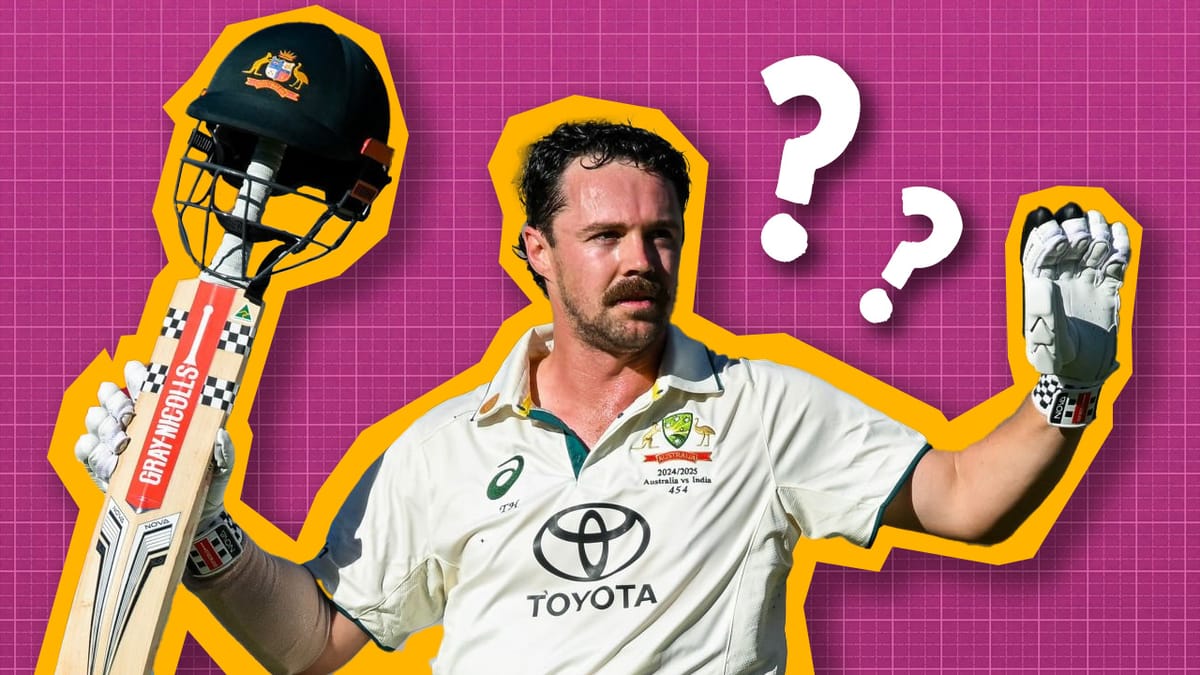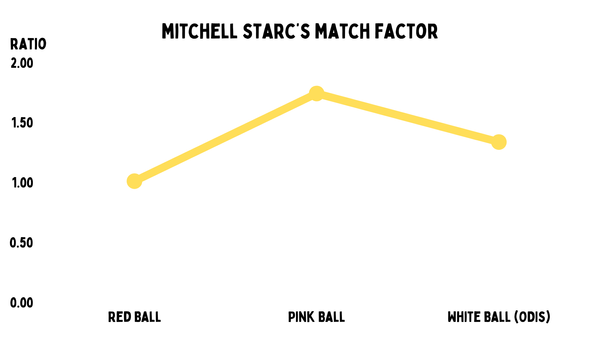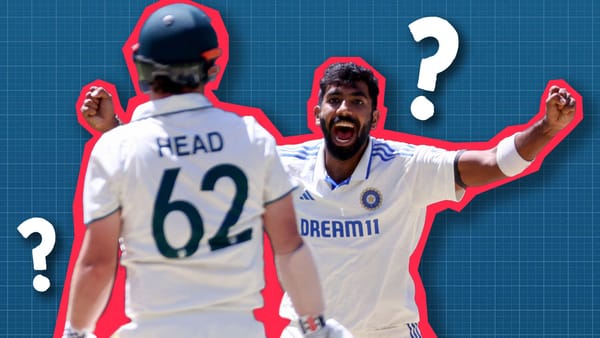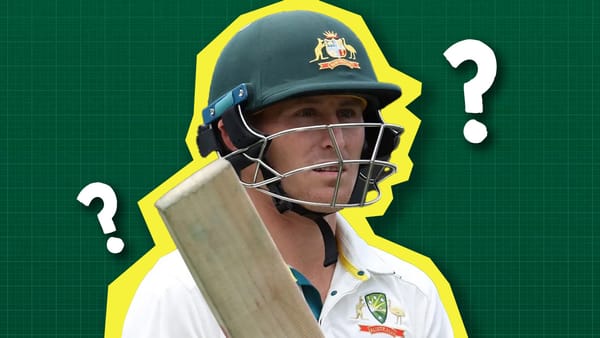Travis Head - the best all-format batter in the world
When Travis Head bats, you don’t care if the ball is white, red or pink; you just hope you’re watching.

Download Hitwicket Cricket Game 2024 - Be the Owner, Coach and Captain of your own Cricket Team | The Ultimate Strategic Cricket-Manager Experience | Not a fad. No ads.
At the start of 2019, Travis Head was co Test vice-captain. Yet, after nearly two years, he was dropped from the team. No one ever talked about his vice-captaincy again. He looked like a lost talent—a batter who only wanted to slash square on the offside, while struggling against spin and right-arm seam around the wicket.
In 2023, he would go on to shatter the dreams of a billion people—twice. When things happen to Head, they seem to go very fast.
Today, he also brought up his eighth Test century in a pink ball Test at the Adelaide Oval. He always smashes India, loves the pink ball, and is an Adelaide boy. This all seems like it was meant to be, but it’s been a few eventful years to get here.
After missing the first five matches, Head pulled off a 1996 Aravinda de Silva in the 2023 World Cup. He was the third-highest run-getter of the T20 World Cup, striking at 158, despite Australia not making the semis. He also had one of the quickest scoring seasons in the history of the IPL in his first year since 2017. In the last three years of Test cricket, he has the fourth-highest strike rate.
Travis Head has gone from a failed Test vice-captain and IPL player, to perhaps the best all-format batter in the world almost as quickly as he scores his runs.
In 2015, Head smashed a List A double hundred. For a star-starved team like South Australia, this was huge. Head was a batter who didn’t just make runs; he destroyed bowlers. The national team was convinced, too. But it wasn’t smooth afterwards. And when he played for Australia, he didn’t look like a dominant player. If anything, he came across as flawed.
Head’s resurgence in international cricket started in the Ashes 2021/22, where he was the highest run-getter in a fairly low-scoring series. But more than the amount of runs, it was the speed that caught everyone’s attention—a strike rate of 86. He smashed Jack Leach’s bowling into oblivion on his way to 152 at the Gabba.
It might not sound so surprising now, but before that series, his career strike rate was less than 50. He was often confused and it was easy to game-plan for him. Since then, it has gone up to almost 80.

Crucially, he scores significantly quicker against both pace and spin now. A player who was slow and unsure, is now fast with bulletproof confidence.

As we said earlier, he has the fourth-best strike rate of all Test batters with over 1000 runs in the last three years. Only Harry Brook, Ben Duckett and Rishabh Pant score quicker. Two of them, like Head, also bat at number five for their teams.

Australia started calling this Travball. It was partly a tongue-in-cheek comment against England, but he was clearly going at bowlers in the same way. There was a chance he might not even play a game in India, because of how he played spin. But he played a brilliant knock in the fourth innings of the Test win in Indore.
Along with such a dramatic increase in his scoring rate, his average has also improved.

Till 2020, he had a brilliant average against spin, but it was less than 30 against pace. That was because he usually faced in Australia or England. He struggled a lot against offspin in the UAE.
Now, he is not worried about the kind of bowler he’s up against, because he just whacks the ball. His inflated average has halved against spin. But against pace, he has gotten much better on both metrics.

Today, we saw him launch R Ashwin, a destroyer of left-handers, back over his head early on. There is a feeling of ride or die. It means a bowling team can be confident in using spin against him. But if it doesn’t work, the game could flip on them.
While he is not a massive outlier in terms of batting average like Brook, his returns are still quite impressive for an attacking batter. Duckett is not too far off, while Pant is a bit better than the two.

He hasn't been that great in Test cricket in the last two years. But that has been hard to notice with what he has done for Australia in major moments—the WTC final, ODI World Cup, T20 World Cup, and in the IPL for the Sunrisers Hyderabad. Perhaps Australia’s top order meant he had to come in earlier at times. Eventually, things would go his way, and he’d dominate again.
Today, Labuschagne and McSweeney saw off the new ball, Bumrah was rested for some time, the lights weren’t on, and India dropped him twice. Those were a lot of things in his favour. But the difference between Head and most batters is the clobbering he can give. Like with Brook, once it starts, teams don’t seem to have any options other than ducking for cover.
The left-hander averages 86.2 against the West Indies, 65.6 versus India and above 50 at more than a run a ball against South Africa. His record against England is also good. Of course, his strike rate has been elite against all these teams. He has struggled to score runs versus New Zealand, Pakistan and Sri Lanka.

He is at his best on home soil, but he also performed very well in India, despite missing the first Test. After scoring a hundred at the Oval in the World Test Championship final, he scored the seventh-most runs (363) in the Ashes. The series against Pakistan was very high-scoring, but he could not make the most of it. In Sri Lanka, he got out twice to offspin and once to left-arm fingerspin.

His away record is still not perfect. But it no longer feels like a dealbreaker. It is now a matter of time before he makes runs everywhere.
At home, he averages 51 in 20 red ball Tests. That goes up to 57 in nine pink ball games. Clearly, he prefers the lighter coloured ball.

Travis Head specifically loves batting in his hometown. Not in Shield matches, where he averages 35, but in Tests. So he averages over 50 at home, and just under 80 at the Adelaide Oval.

Today was a pink ball Test, in Adelaide, against India. Head brought up his eighth Test hundred, and sixth in the last three years. Thinking about it that way, you’d say he was bound to make runs here. But while he has had some incredible moments in Tests, it is the white ball game he’s been tearing down.
He returned to the ODI team against Pakistan in March 2022. His first innings was 101 off just 72 balls. That would be the start of something special.
Since 2022, Head has the second-best true strike rate in ODIs, only behind Rohit Sharma. But he also has the second-best true average after Shubman Gill. Rohit and Gill were an incredible opening pair for India in the World Cup. So only Gill is better than Head at not being dismissed, and Head also matches Rohit’s ramped-up strike rate.

One of those would be impressive; two is mind-blowing. He is taking incredible chances when batting, and they are coming off with high frequency.
But he isn't getting his eye in and then going, like Chris Gayle. When we look at the quickest starters according to true values, only Rohit is ahead of him. Shreyas Iyer, the third-best, is behind by some distance. He is deciding to hit from the start of the innings, and stopping when the opposition is lucky enough to have dismissed him.

In the big dance, he again had the best true strike rate. He was quicker than both Maxwell and high-intent Rohit. His true average was also higher than Rohit's. He had two hundreds, a fifty, and three low scores in six innings. The first century came against New Zealand in Dharamsala, where he hammered 109 off just 67 balls. It was at a crucial time in the tournament. After getting Klaasen and Jansen in the first innings of the semi-final, he scored 62 off 48 balls to set up the chase on a tough wicket.

And then came the final. He took a famous catch to dismiss Rohit Sharma. Did he also score the best World Cup final hundred? There have been some doozies, but he certainly sliced the game into pieces and got Australia their sixth men’s ODI World Cup against an Indian juggernaut who were undefeated till then in a home World Cup.
There aren’t many players in the world who would have that kind of impact on a big game. And if you include his runs in the WTC final as well. He has done things that most players simply cannot, twice.
The next white-ball tournament he dominated was the IPL. His partnership with Abhishek Sharma meant there was a new moniker in town—Travishek. SRH couldn’t win the IPL, losing to the Kolkata Knight Riders in the final. However, their style of play was not just entertaining but also extremely effective. Only Jake Fraser-McGurk and Abhishek had a better true strike rate than him, and his true average was better than both. His nearest neighbours on this chart are Sunil Narine and Phil Salt—the opening pair that was extremely crucial in KKR’s title win.

In 2016, RCB had huge hopes from him, and by 2018, no team was all that interested. The talk around the league was that he would never be able to play spin, and wasn’t good enough against pace to overcome it. He comes back seven years later, and scores quicker than few players ever have.
None of that is normal.
The T20 World Cup was a tournament set up for batters to fail. He did not. In the group stage, he got a couple of quick 30s against England and Namibia, followed by 68 against Scotland. He played another cameo against Bangladesh, and played a brilliant knock against India in a losing cause. His only failure was a duck against Afghanistan, which was probably the difference between Australia qualifying for the semi-final and potentially winning the tournament.

We see that in all formats, when Head gets out, it is like all hope is lost for the batting team. When he gets going, he is so inevitable that his dismissal feels like losing two wickets.
So, is he the best all-format batter currently? Who are the other batters with good cases?
Yashasvi Jaiswal is a special talent, but he’s yet to make his ODI debut. Harry Brook is arguably better than Head in Tests, but so far he’s not reached that level in white-ball cricket. Rishabh Pant is another batter that has done well in all three formats, but a serious injury kept him out of the game for more than a year. That meant he could not take part in the ODI World Cup. Shubman Gill and Rachin Ravindra are also good batters, but they are yet to dominate.
No batter is an outlier in all three formats like he is. But with him, it is about more than just the runs, or sometimes even the speed. When Travis Head bats, you don’t care if the ball is white, red or pink; you just hope you’re watching.






